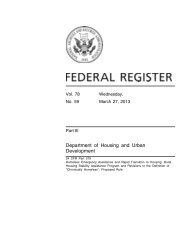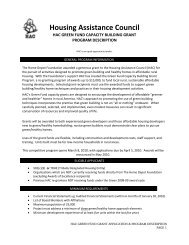Public Relations Guide for Rural Housing Organizations (manual
Public Relations Guide for Rural Housing Organizations (manual
Public Relations Guide for Rural Housing Organizations (manual
Create successful ePaper yourself
Turn your PDF publications into a flip-book with our unique Google optimized e-Paper software.
“Media relations can make or break you,” according to Renee Wilburn, director of Lee CountyCommunity Development Corporation (LCCDC) in Marianna, Ark. Admittedly, part of Renee’ssuccess with reporters was based on her office location – right across the street from the localnewspaper’s office – making it very easy <strong>for</strong> the newspaper to come to her <strong>for</strong> last minutearticles and photographs. But a good bit of her success was due to her keeping in touch withthe news media. Frequently nearby radio and TV stations called Renee asking <strong>for</strong> good storiesto cover. “There is one reporter from the Little Rock TV station who always keeps in touchwith us,” she said. Media coverage helped LCCDC to become so well known in the region thatRenee did not need to do much advertising.Use Your LibraryChart past press coverage by browsing the archives of newspapers and periodicals.Spend time in the public library or the reference room of your local newspaper.Review how the national media covers the issue. Find out if the local mediahave done similar stories. If they have, track by-lines and start a notebook of thecoverage. If they have not, suggest stories when you approach reporters andeditors with ideas. (Bonk and Sparks 1991, 13)Why was a certain story done? What made it newsworthy? Could a similarstory be done about your group or leaders or programs? (Center <strong>for</strong> CommunityChange 1997, 15)Note trends in news coverage. It is amazing how the media will latch onto astory or issue <strong>for</strong> a while, then totally drop it. One key is to relate your issue orperspective to these fads. (Center <strong>for</strong> Community Change 1997, 19)Prepare Written Background Materials.It is a very good investment of your time to have assembled a collection of all the items youwould want distributed to the press well ahead of time, since the media have a way of catchingyou off-guard. This kit should include everything you would distribute as a response to generalinquiries about your organization. This material is also put in conference, training, and eventpackets, even if you think the attendees already know about your organization. Always makesure your materials reflect current in<strong>for</strong>mation, such as turnover of staff or board members orchanges in the programs you offer.If your organization does not already have a short one-paragraph description, create one.Write it in a way that makes the facts interesting to someone you like. Use this paragraphconsistently on your brochure, fact sheets, web page, press releases, and media advisories.Translate it into other languages used in your community as an invitation <strong>for</strong> non-Englishspeakingindividuals to approach you.Brief fact sheets can be very helpful <strong>for</strong> reporters. If your organization does not have a currentbrochure, or if your brochure is more than a couple of pages long, develop a one-page fact<strong>Housing</strong> Assistance Council 13









